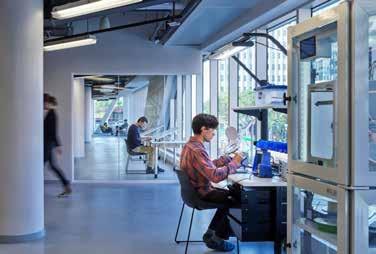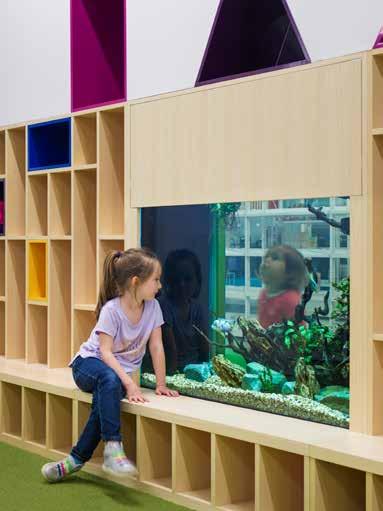
11 minute read
NEW CHAPTER FOR EDMONTON PUBLIC LIBRARY
from CFMD December 2020
by MediaEdge
Imagine. That is the word, in bright mosaic colours, greeting patrons inside the north entrance of the newly renovated Stanley A. Milner Library—the Edmonton Public Library’s flagship branch. Located in the city’s downtown core, the building is a token of what a civic centre can become—a place for equity, inclusion and barrier-free access to knowledge, according to Edmonton Mayor Don Iveson who spoke at the opening on September 17.
“Truly public spaces where everyone is welcome without barriers are getting rarer and rarer, but this city believes we need more of those spaces, not less,” he said.
Advertisement
One of the library’s most celebrated new features is Thunderbird Lodge, an intricately-crafted Indigenous gathering space designed in consultation with local communities and Cree elders Jo-Ann and Jerry Saddleback. As an act of reconciliation, it brings access to culture for indigenous cultural practices, while demystifying ceremony for all groups of city-dwellers.
Stephen Teeple, of Teeple Architects who designed the library alongside Stantec, notes it was also built with its own special mechanical system to enable a true smudging space. “I think it’s the only space in Edmonton where smudging is built right into the space; you can literally smudge there anytime,” he says, adding that it’s also “acoustically amazing.”
Another hard-to-miss feature is the Shelly Milner Children’s Library,


FROM LEFT TO RIGHT: MAKERSPACE, THUNDERBIRD LODGE; SHELLY MILNER CHILDREN’S LIBRARY; STACKS AND NATURAL WAYFINDING. PHOTOS BY: ANDREW LATREILLE

relocated from the north side of the building to the south side where it overlooks and opens onto Centennial Plaza so natural light can pour in. Now three times larger than its previous space, Teeple refers to it as a “mini version of the big library,” as it is more multi-functional; there are numerous programs for kids, including a makerspace with 25,000 pieces of Lego. On one wall, 54 art pieces form into a collage of mountains and oceans and see-through aquariums. A daycare is currently under construction.
Other key features include a gaming room, a teaching kitchen, the addition of 70 public computers, large galleria spaces, a café, and an adult makerspace for programs like music, carpentry and 3D-printing. Towering above is a two-story interactive simulation wall made up of 278 digital screens, serving as both a communications and learning tool to engage library-goers.
Near the stacks—currently housing a collection of 150,000 items—fuchsia, lime-green and blue chairs circle around low tables in lounging areas, brightening up an already light-filled space.
Outside, the exterior reflects much of what the library reboot set out to do.
“The vision of the building is to stretch the library out into the city—to draw people into this wide variety of services. When you enter the building, you see up through to a new atrium and it leads you where you want to go—to all these exciting dynamic community services,” says Teeple. “You can see in the building skin how the envelope stretches off the original static box of the original structure.”
He refers to the interior and exterior as “reciprocal equals.” The stretching of the building skin out into the city and the dynamic folding toward the corner create the interior atrium, drawing people inside. The exterior is also laden with 396 more windows than before.
To significantly improve energy performance, a high-tech recladding gives the building great insulating value, says Teeple. The designers used a lightcoloured azengar—a high-quality, long-
lasting zinc that is popular in Europe and more obscure in Canada.
As the library was completely transformed inside, except for an old, yet reusable theatre in the basement, the project came with challenges.
“The fact that it’s a seismic upgrade of an existing concrete structure with all new mechanical and electrical systems is super challenging,” says Teeple. “You’re working within a lot of resisting constraints, and to really reimagine it is pretty challenging— to truly transform it into a new space appropriate for today.”
The library first opened in 1967 as Edmonton’s Centennial Library and was given its current name in 1996. Over the years, it housed everything from a petting zoo in a children’s library to a smoking room shut down in the 1970s, according to one EPL board member who knows its history well. When it opened, a library card cost more than it does today: adults paid one quarter and a child’s library card cost five cents.
In 2015, the city reached out to its citizens, asking them what they wanted in a renewed downtown library. People wanted a “destination, a place to hang out and spend time, a place to create, to borrow library materials, to collaborate, to learn and incubate new ideas—most of all, a place to connect and feel part of something bigger,” EPL CEO Pilar Martinez said during the opening ceremony.
Many of these ideas transpired within the $84.5-million renewal, replacing the small windows and dense floorplate, the dark and isolated spaces of the past. New connections come in many forms— through programming and through the library’s intuitive and accessible circulation paths.
“What it brings is a natural wayfinding, so the moment you enter through the door, your eye is led on a path leading to all the various services,” adds Teeple. “It’s a very intuitive building, even though spaciously it’s very diverse, very rich and seemingly quite complex.”
Currently, the library is open with a limited patronage and pandemic protocols in place.
“It was designed before the pandemic unfolded, but it works well as a much spacious facility with lots of room for people to maintain social distancing and have their own nook in which they can read,” says Teeple, adding, “the pandemic will come and go; the library will stay.” | CFM&D



Improving IAQ in the New Normal Promoting healthy indoor environments in the time of COVID-19
Building owners and engineers recognize that the built environment is complex and evolving. Each building presents unique challenges that can vary from hour to hour and season to season. The outbreak of COVID-19 has added a new element to this complexity. Health experts agree that the risk of indoor disease transmission differs based on occupant density, work- and traffic flows, the presence of “hot spots” (such as food preparation areas), social distancing, hand-washing, disinfectant practices and the use of personal protective equipment. Contact, droplet, airborne and surface transmission are all possible vectors for spreading disease. Consequently, a “layered” strategy based on comprehensive planning and strengthened administrative controls can help to minimize disease transmission in the workplace.
Of the several potential transmission vectors, the threat of infection from airborne transmission caused by droplet nuclei (or aerosols) that remain suspended in air over long distances and times has been the most difficult to assess. A letter signed in July 2020 by more than 200 scientists and engineers concluded that “there is every reason to expect” that SARS-CoV-2 transmission by airborne microdroplets is an important transmission pathway. The letter found that hand-washing and social distancing are insufficient to provide protection from virus-carrying respiratory microdroplets. The authors recommended additional focus on effective ventilation along with measures to enhance airborne infection control.
The World Health Organization (WHO), which regularly updates its understanding of how COVID-19 is transmitted, responded to this information by concluding that short-range aerosol transmission in crowded and inadequately ventilated indoor spaces over a prolonged period of time with infected persons “cannot be ruled out.” In addition, a recent evaluation of virus containment in air-handling systems recommends a number of measures that can improve an HVAC system’s effectiveness in reducing transmission.
While analysis is ongoing, these findings reinforce that buildings are a first line of defense in reducing COVID-19 transmission, and a renewed focus on IAQ is fundamental to this role.
As building owners and engineers reopen their facilities, plans for occupant safety and wellness will vary as widely as the built environments to which they return. Some owners may seek specific actions designed to reduce the threat of disease transmission. Others may pursue a more holistic approach to improving IAQ, including energy efficiency, operational cost savings, code compliance, greenhouse gas reduction and occupant wellness — along with the slowing of virus transmission.
IAQ measures the health and comfort of a building’s interior air, focusing on the presence of contaminants such as particulate matter (on which viruses such as SARS-CoV-2 are sometimes found), carbon monoxide and volatile organic compounds (VOCs). Particulate matter is a combination of solid particles and liquid droplets that may include dust, pollen and smoke. VOCs are ubiquitous (and often
Indoor Environmental Quality
Contaminants, Dust, Particulate Matter
Indoor Air Quality
Viruses & Bacteria Carbon Monoxide Volatile Organic Compounds (VOCs) Other (Radon, Carbon Dioxide, Nitrogen Dioxide, Methane, etc.)

HVAC strategies focused here can impact occupant safety, comfort, productivity and energy consumption
Thermal Comfort Lighting Acoustics Water Quality
Source: Carrier
Poor IAQ can lead to headaches, fatigue, lack of concentration, and irritation of the eyes, nose, throat and lungs.5 Conversely, “Buildings are a first line of defense in reducing COVID-19 IAQ optimized for VOCs, carbon dioxide and outdoor air ventilation has been shown to significantly improve cognitive transmission, and a renewed focus on IAQ is fundamental functioning of office workers across nine measurements — including crisis response, information usage and strategy.6
to this role.” As sensors have become more accurate and affordable, building owners are now able to measure nearly every important attribute of IAQ. Sensors for carbon monoxide, particulate matter, VOCs and other contaminants can be set to track conditions over time and programmed for threshold alarms. odorous), arising from cleaning agents, air Often, the first step in preparing a building These assessments can be greatly facilitated for reopening is to bring the HVAC system back to its original, commissioned state, undertaking where there is a control system with suitable instrumentation and range in complexity from a fresheners and new carpets. HVAC strategies can have a significant impact on reducing these The extraction of this rich data can help accurately describe the built environment and allow building owners gain the a “tactical commissioning” of their building basic assessment, including a limited site walk-contaminants in the built environment. needed insights to balance optimum IAQ against energy consumption and occupant comfort. Applying these data insights system to ensure that it is operating per design through usually intended for smaller sites, to a IAQ is a subset of indoor environmental quality and better managing the building will require close collaboration between the building owner’s engineering and (IEQ), which also includes thermal comfort, conditions and current operational strategies. comprehensive assessment complete with This activity is usually accomplished with the lighting, acoustics and water quality. IEQ is an operations team and their outside HVAC engineers. recommendations and an execution plan. important component of the LEED® (Leadership in assistance of a licensed and certified To help deliver healthier, safer, efficient and Energy and Environmental Design) rating system. commissioning provider, a test and balance productive indoor environments. Carrier
Poor IAQ can lead to headaches, fatigue, lack of company and/or a building automation systems introduced its Healthy Buildings Program, a concentration, and irritation of the eyes, nose, company. Posted: September 2020 suite of advanced solutions for commercial 3 throat and lungs. Conversely, IAQ optimized for The results of a tactical commissioning can buildings, healthcare, hospitality, education, VOCs, carbon dioxide and outdoor air ventilation create substantial energy savings or retail and marine. The program draws from a has been shown to significantly improve cognitive improvements to IAQ. comprehensive set of solutions designed to functioning of office workers across nine If the focus of a building operator is on reducing help improve IAQ by increasing outside air, measurements — including crisis response, the risk of infectious aerosols, then improving temperature and humidity levels, information usage and strategy. recommendations for reoccupancy often key on managing occupancy density, optimizing
As sensors have become more accurate and improving ventilation, pressurization, airflow energy efficiency and enabling touchless affordable, building owners are now able to distribution and optimization, mechanical interactions. measure nearly every important attribute of IAQ. filtration, ultraviolet germicidal irradiation (UVGI) Carrier’s healthy buildings technologies Sensors for carbon monoxide, particulate matter, and humidity control. In order to understand these include a variety of equipment and service VOCs and other contaminants can be set to track opportunities, owners may be presented with options, many of which are available to conditions over time and programmed for several levels of review, each different in time, enhance IAQ and occupant safety in existing threshold alarms. expense and comprehensiveness. buildings.
The extraction of this rich data can help accurately describe the built environment and allow building owners gain the needed insights to To learn more about Carrier and read white papers visit carrier.com/commercial/en/us/healthy-buildings/ balance optimum IAQ against energy consumption and occupant comfort. Applying these data insights and better managing the building will require close collaboration between the building owner’s engineering and operations team and their outside HVAC engineers.





